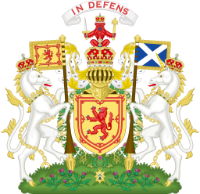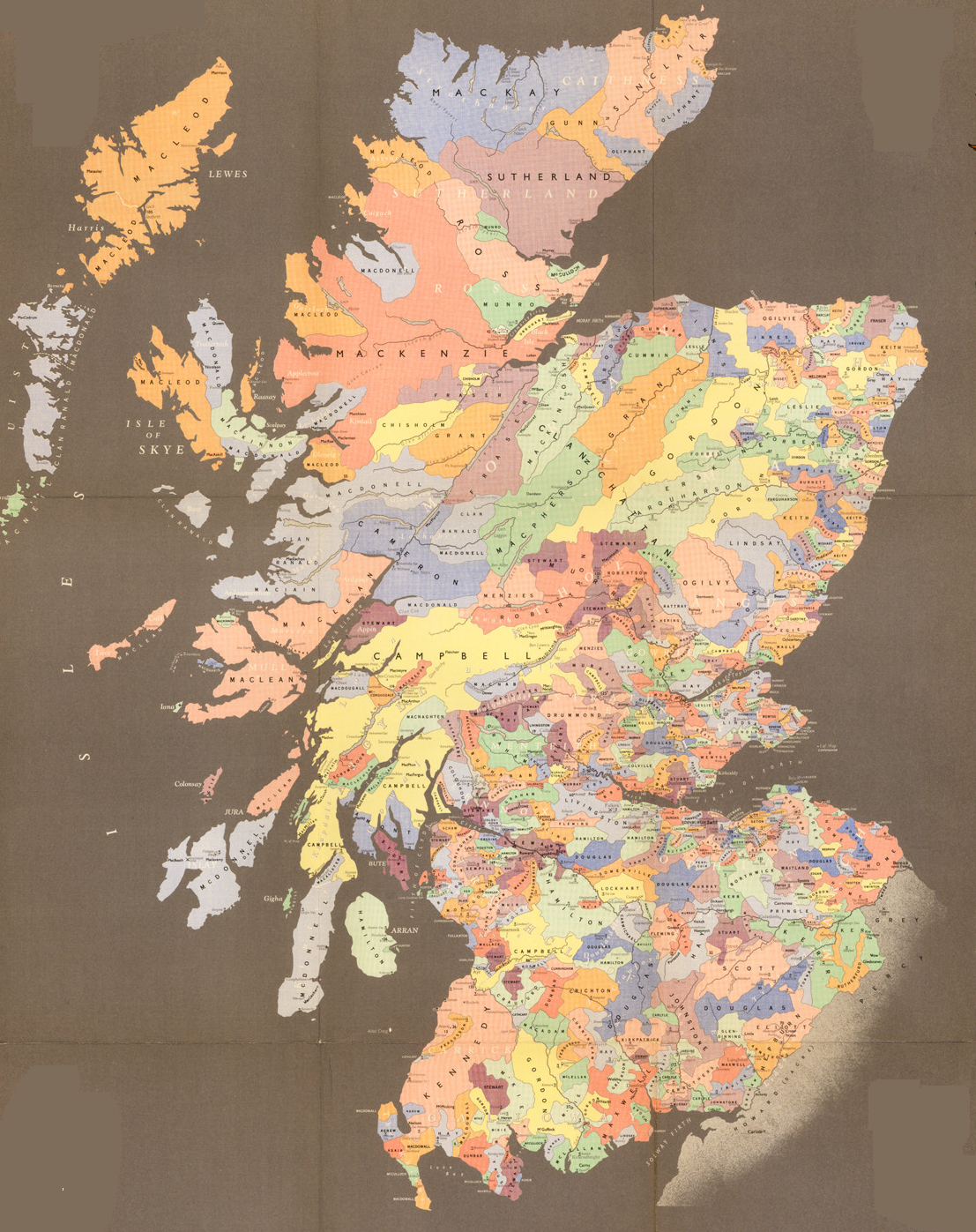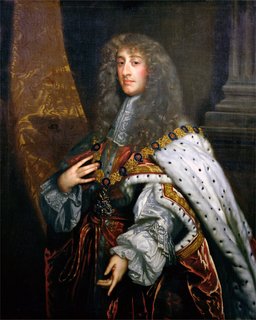Kingdom of Ireland Ꞃíoᵹaċt Éiꞃeann / Ríoghacht Éireann |
 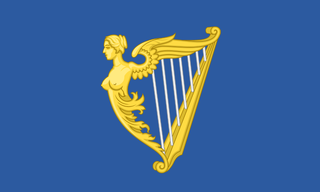 |
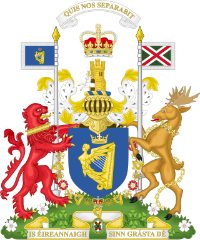 |
| Mottos: Quis Nos Separabit (Who Will Separate Us) Is Éireannaigh Sinn Grásta Dé (We are Irish by God's Grace) Unofficial: Éirinn go Brách (Ireland Forever) |
| Capital And Largest City : Ꝺuiḃlinn |
| Population: Kingdom of Ireland: ~2,060,000 Across Personal Union: ~3,260,000 |
| Demographics: 82% Irish 8% Scottish 5% English 5% Other |
| National Language: Irish |
| Minority Languages: Scots, Scottish, English & various English dialects |
| State Religion: Roman Catholicism |
| Protected Minority Religion: Presbyterianism |
| Demonym: Irish |
| Unofficial Anthem: Mo Ᵹile Mear (My Gallant Lad) |
| Government: Constitutional Elective Monarchy |
| King of Ireland: James VII & II Stuart Séamus VII & II Stiùbhart |
| Tanist: Unoccupied |
| Lord Chancellor of Ireland: Richard Talbot, 1st Earl of Tyrconnell |
| Speaker of the Airecht: Henry Colley |
| Legislature: Parlaimint na hÉiꞃeann Upper House: Cóimeáil na ꟑꞆaoiꞅiꟑ Lower House: Aiꞃeċꞇ |
| Currency: Gaelic Punt (£) |
Kingdom of Ireland
Ꞃíoᵹaċt Éiꞃeann / Ríoghacht Éireann
Ꞃíoᵹaċt Éiꞃeann / Ríoghacht Éireann
The Kingdom of Ireland is a Constitutional Elective Monarchy located on the island of Ireland and its minor outlying islands, in addition to its colonial possessions in the Americas and Africa. Ireland has a population of about 2 million, and the national language is Irish, also known as Gaeilge.
Culture & Language
The Irish language (Irish: Gaeilge) is a Goidelic Gaelic language which is the most commonly spoken language of Ireland. Irish can be written in two scripts, standard script which is referred to as Roman Type, and Gaelic Type. Gaelic type accounts for Irish lenition with dots above certain letters, as well as replacement letters for D, F, G, R, S and T with Ꝺ, Ꝼ, Ꟑ, Ꞃ, Ꞅ and Ꞇ respectively, with an additional letter, Ᵹ to denote gh.
The Irish clan system forms the foundation of Irish society, but has only been recently rekindled after English had begun breaking it down during the Lordship of Ireland. Under the Stuarts, the Clan system has been reorganized, with Stuart Loyalist families (the vast majority of which are Catholic) being granted "Landed Earldoms" of 30 of the 32 counties of Ireland. Smaller, less prestigious, or neutral families were given smaller lands and titles. Much like how Scotland has been organized around the clan system, Ireland's clans were built up to a base of political authority in Ireland both for ease of understanding the Irish political field, while also gaining the support of nationalists in Ireland by respecting traditional systems the English had previously been trying to break down.
Government
Ireland is a Constitutional Elective Monarchy headed by the King of Ireland (Rí Éireann), the current holder of the title being Séamus VII & II. The King forms the executive alongside his council, the Irish Council, which is comprised of the King's appointed ministers. The King & Irish Council splits power with the Irish Parliament (Parlaimint na hÉireann), a bicameral legislature with a House of Lords (Cóimeáil na gTaoisigh, literally Assembly of the Chiefs) and House of Commons (Airecht, Assembly of Freemen).
The election of the King is based on the Celtic legal custom of Tanistry, whereby the nobility elect the successor from among the ruler's Derbfine (English: True Kin) and of age to assume the title. However, practically the heir is chosen from among the gelfhine, those eligible that are descended from the current King's grandfather. Traditionally the title of Tánaiste would be an appointed position during the lifetime of the ruler, to immediately take succession upon their death and is elected by the family. Instead, the modified Tanistry used by the Kingdoms of Ireland and Scotland elect the Tanist from agreement in the Scottish and Irish parliaments, with approval from the members of the House of Stuart.
The King rules through the clan systems and alongside Parliament, itself being made up largely of those Clan Chiefs or their relatives. The chiefs of all clans swear loyalty to the King but those of lower status swear loyalty to their Landed Earl-Clan as well. Those living within a county pay tax both to the central government as well as their landed Earl-Clan.
Peerage
Ireland is broken down by Provinces whos monarch holds the title of Duke, and then by counties whos nobles hold the title of Earl or Count. The King holds the title of Duke of Meath in addition to King of Ireland, among other titles. The title Duke of Meath is only associated with the lands comprising County Dublin, Louth, Meath and Westmeath, the rest of its traditional land having been absorbed by the Province of Leinster. In addition to the traditional peerage titles in Ireland, there is an additional title of Lord of Ulster, a position held by the Heir Apparent and is equivalent to the title Prince of Wales in England or Archduke of Austria in the Austrian Empire. Legally, the Lord of Ulster is above the Duke of Ulster and exists to enforce their loyalty, but in practice has no effective authority over them. Irish colonies are considered Marches (Marcshlua) in noble title, and the holder is considered a Marquis (Marcais). Despite the use of the March as a hereditary title in much of Europe, these positions are analagous to the Viceroy of Spanish colonies.
Ireland's nobility terminology was largely unstandardized until the formation of the Kingdom of Ireland as an independent entity. Shortly after gaining control of Ireland, King James II forced through a large series of laws which standardized terms such as "Clan" and "Sept" as well as reforming noble titles into standards. There are the five provinces of Ireland which correspond to the title of Duke/Duchess, and the 32 counties of Ireland which correspond to the title of Earl. These laws were noticably not retroactive, meaning titles of Earl or Duke that do not correspond to the current system shall remain in place.
In terms of lineage, Irish families are organized by Ancestor/Réamhtheachtaí --> Dynasty/Ríshliocht --> Clan/Clann --> Sept/Sliocht (as applicable). However, as written and presented one begins with the most specific (Clan or Sept) and works backward. An example would be the full familial title of Brigadier General Daniel O'Donnell: Dainéil Ó Dónaill of the Uí Fiachrach Dynasty of the Connachta. He is of Clan O'Donnell, which itself is part of the Uí Fiachrach, itself part of the Connachta, a collection of Dynasties descended from High King Conn Cétchathach. A notable instance would be Clans of foreign origin, such as the FitzGeralds. The house then uses the Parent House (as applicable) as the Dynasty and that parent's founder as the Ancestor, or skip straight to Ancestor should that be required. For the FitzGeralds, they are the "Mac Gearailt of the Uí Gherardiach".





